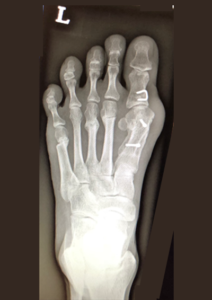What is Hallux Valgus, and is it the same as a Bunion?
The term bunion was derived from the Latin word Bunio, which means turnip. This has led to some confusion as it may be used to describe any enlargement or deformity of the 1st Metatarsophalangeal Joint (great Toe), including bursitis, gout, ganglion, and indeed the Hallux Valgus, which is the condition we are discussing here.

A more accurate term is Hallux Valgus. Coined by Carl Heuter, it describes the condition in which there is a subluxation of the 1st Metatarsophalangeal (MTP) joint, in which the big toe points outwards.
What is the cause of Hallux valgus? Is it due to the wearing of high-heel/ narrow shoes?
The causes have been debated for a century. In the past, many suggested that it was due to the wearing of footwear -high-heel shoes in particular.
However, this does not explain the prevalence of Hallux Valgus in the community of people who had never worn shoes (such as tribal populations). It also does not account for the many individuals who wear fashionable footwear and don’t develop this condition.
It is now postulated to be multifactorial, with a genetic predisposition being a strong contender for etiology.
Studies have demonstrated 70-90% of patients with Hallux Valgus have at least one affected relative. This also explains why females tend to be affected more than males, with a ratio of 9-15:1.
High Heels are commonly blamed for Hallux Valgus. While they may not be the cause of it, they certainly play a role in exacerbating the condition and leading to progression. This is because the foot is tipped into sliding forwards due to gravity, into a narrow space.
What are some of the symptoms?
Symptoms include pain in the joint, or pain from pressure over the part of the foot that is compressed by footwear. The patient may start to experience difficulty with footwear, and subsequently walking.
As the disease progresses, the 2nd toe may start to override the great toe. The 2nd toe may then start to experience symptoms due to compression from footwear.
One may also experience pain under the 2nd metatarsal head. These occur because there is abnormal distribution of weight to the 2nd toe with the Big toe no longer carrying the weight normally.
Is treatment necessary?
Not everyone with the condition will experience problems. Some remain asymptomatic.
If the symptoms one experiences are due to problems with footwear, then a simple change of footwear to one with a larger toe-box may suffice.
If the symptoms one is experiencing is due to pain in the joint as stated above, then it may be prudent to have it looked at by a doctor, as certain conditions could do better with early intervention.
Is surgery the only option?
As stated above, not every case requires treatment intervention. If asymptomatic, it can be left alone. Depending on the patient’s symptoms and clinical examination, it may be possible to alleviate the symptoms by simply having a change of footwear and adding a toe-spacer. Toe-spacers are for symptom-relief and are not curative.
Cases in which the above conservative measures are insufficient would do better with surgical intervention.
Is it a major surgical procedure?
Hallux Valgus is not a simple entity to treat as there are many different variants and exacerbating causes. If these are not addressed, the condition may recur.
Whilst the surgery itself is not major nor complicated, one has to choose the right form of surgery to address the underlying issues. This can range from open surgery, the fusion of joint, to minimally invasive techniques.
We advise that the patient be seen by an orthopaedic surgeon, preferably one subspecialized in Foot And Ankle Surgery, for a more expert opinion.

Some cases are amenable to a minimally invasive method of surgical correction.

Are there any prevention tips?
There are no prevention tips per se.
However, one can avoid exacerbating the condition by avoiding the wearing of constrictive narrow toe-box shoes – high heel shoes in particular.
We advise the wearing of comfortable sports shoes with a wide toe-box. There is no evidence to show that the use of toe-spacers can correct or prevent further progression either. They are used more for symptom relief to a certain extent.
Looking For A Reliable Foot & Ankle Orthopaedic Specialist?
Fast Medical Attention, Transparent Fees
Make an appointment for comprehensive care for your Foot & Ankle problems!
